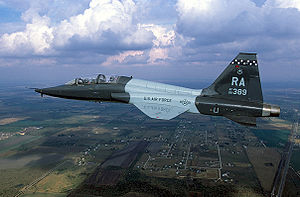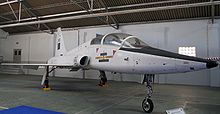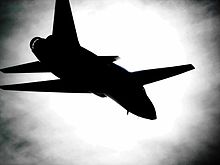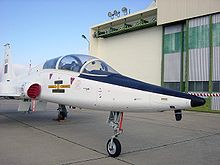- Northrop T-38 Talon
-
T-38 Talon A USAF T-38A Talon from 560th Flying Training Squadron, Randolph Air Force Base Texas, flying over the Texas countryside in 2001 Role Advanced trainer National origin United States Manufacturer Northrop Corporation First flight 10 March 1959 Introduction 17 March 1961 Status Operational Primary users United States Air Force
Turkish Air Force
United States Navy
NASAProduced 1961–72 Number built 1,187 Unit cost US$756,000 (1961 constant dollars) Developed from Northrop N-156 Variants Northrop F-5 The Northrop T-38 Talon is a twin-engine supersonic jet trainer. It was the world's first supersonic trainer and is also the most produced. The T-38 remains in service as of 2011 in air forces throughout the world.
The United States Air Force (USAF) is the largest operator of the T-38. In addition to training USAF pilots, the T-38 is used by NASA. The US Naval Test Pilot School is the principal US Navy operator (other T-38s were previously used as USN aggressor aircraft until replaced by the similar Northrop F-5 Tiger II), as well as some NATO pilots participating in joint training programs, also fly the T-38.
Contents
Design and development
The basic airframe was used for the light combat aircraft F-5 Freedom Fighter family. In the 1950s Northrop began studying lightweight and more affordable fighter designs. The company began with its single-engine Northrop N-102 "Fang" concept.[1] The N-102 was facing weight and cost growth, so the project was canceled and the company N-156 project was begun.[2]
Although the USAF had no need for a small fighter at the time, it became interested in the trainer as a replacement for the T-33 Shooting Star it was then using in that role. The first of three prototypes (designated YT-38) flew on 10 March 1959.[3] The type was quickly adopted and the first production examples were delivered in 1961, officially entering service on 17 March that year, complementing the T-37 primary jet trainer. When production ended in 1972, 1,187 T-38s had been built. Since its introduction, it is estimated that some 50,000 military pilots have trained on this aircraft. The USAF remains one of the few armed flying forces using dedicated supersonic final trainers, as most, such as the US Navy, use high subsonic trainers.[4]
The T-38 is of conventional configuration, with a small, low, long-chord wing, a single vertical stabilizer, and tricycle undercarriage. The aircraft seats a student pilot and instructor in tandem, and has intakes for its two turbojet engines at the wing roots. Its nimble performance has earned it the nickname white rocket. In 1962 the T-38 set absolute time-to-climb records for 3000, 6000, 9000 and 12000 meters, beating the records for those altitudes set by the F-104 in December 1958. (The F-4 beat the T-38's records less than a month later.)
 USAF Thunderbirds flying T-38 Talons in formation.
USAF Thunderbirds flying T-38 Talons in formation.
The F-5B and F (which also derive from the N-156) can be distinguished from the T-38 by the wings; the wing of the T-38 meets the fuselage straight and ends square, while the F-5 has leading edge extensions near the wing roots and wingtip launch rails for air to air missiles. Under the paint the T-38 wing is constructed of honeycomb material while the wing of the F-5 family uses conventional skin over underlying support structure.[4]
Most T-38s built were of the T-38A variant, but the USAF also had a small number of aircraft that had been converted for weapons training. These aircraft (designated AT-38B) had been fitted with a gunsight and could carry a gunpod, rockets, or bombs on a centerline pylon. In 2003, 562 T-38s were still operational with the USAF and are currently undergoing structural and avionics programs (T-38C) to extend their service life to 2020. Improvements include the addition of a HUD, GPS, INS (Inertial Navigation System), and TCAS as well as PMP (a propulsion modification to improve low-altitude engine thrust). Many USAF variants (T-38A and AT-38B) are being converted to the T-38C standard.
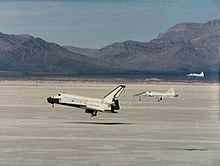 Two T-38 Talon chase planes follow Space Shuttle Columbia as it lands at Northrop Strip in White Sands, New Mexico, ending its mission STS-3.
Two T-38 Talon chase planes follow Space Shuttle Columbia as it lands at Northrop Strip in White Sands, New Mexico, ending its mission STS-3.
The fighter version of the N-156 was eventually selected for the US Military Assistance Program and produced as the F-5 Freedom Fighter. Many of these have since reverted to a weapons training role as various air forces have introduced newer types into service. The F-5G was an advanced single engine variant later renamed the F-20 Tigershark.
Operational history
Military
The USAF Strategic Air Command (SAC) had T-38 Talons in service from 1978 until SAC's deactivation in 1991.These aircraft were used to enhance the career development of bomber co-pilots through the "Accelerated Copilot Enrichment Program". They were later used as proficiency aircraft for all B-52 and B-1 pilots, as well as Lockheed SR-71, U-2, Boeing KC-135, and KC-10 pilots. SAC's successor, the Air Combat Command (ACC), continues to retain T-38s as proficiency aircraft for U-2 pilots.[4]
The Air Training Command's (ATC) successor, the Air Education and Training Command (AETC), uses the T-38C to prepare pilots for aircraft such as the F-15C Eagle and F-15E Strike Eagle, as well as the F-16 Fighting Falcon, B-52 Stratofortress, B-1B Lancer, A-10 Thunderbolt and F-22 Raptor. The AETC received T-38Cs in 2001 as part of the Avionics Upgrade Program. The T-38Cs owned by the AETC have undergone propulsion modernization which replaces major engine components to enhance reliability and maintainability, and an engine inlet/injector modification to increase available takeoff thrust.[4] These upgrades and modifications, with the Pacer Classic program, should extend the service life of T-38s to 2020.
T-38 in Portuguese Air Force colours
Besides the USAF, USN and NASA, other T-38 operators include the German Luftwaffe, the Portuguese Air Force, the Republic of China Air Force, and the Turkish Air Force.[4]
NASA
NASA operates a fleet of 32 T-38 aircraft[5] and uses the aircraft as a jet trainer for its astronauts, as well as a chase plane. Its fleet is housed primarily at Ellington Field in Houston, Texas. NASA’s internal projections show the number of operational jet trainers falling to 16 by 2015. The agency spends between $25 million and $30 million annually to fly and maintain the T-38s.[6]
Civil
According to the FAA there are seven privately owned T38s in the U.S.[5] Boeing owns two T-38's which it uses as chase planes.[5] Thornton Corp. owns three T-38's and three F-5s.[5] In addition, ILOAJP HOLDING and Wayne L. Siltanen own one each.[5]
Accidents
NASA's T-38s were involved in four separate fatal accidents in the 1960s and 1970s, and several non-fatal incidents.
- 1964 Oct 31: Astronaut Theodore Freeman was killed as a result of a bird strike.[7][8]
- 1966 February 28: Astronauts Elliott See and Charles Bassett struck a building in fog, resulting in fatalities. [9][10]
- 1967 October 05: Astronaut Clifton "C.C." Williams was killed in a crash due to an aileron jam.[11][12]
- 1972 Jan 20: NASA pilot Stewart M. Present and NASA pilot Mark C. Heath were killed when they crashed during an instrument approach in fog.[13]
In response to the 1973 OPEC oil embargo, from 1974 to 1983, the U.S. Air Force Thunderbirds aerobatic display team adopted the T-38 Talon, which used far less fuel than the F-4 Phantom. The Blue Angels downsized to the Douglas A-4 Skyhawk at roughly the same time. After the infamous 1982 "Diamond Crash" incident that killed four of the Thunderbirds' six demonstration pilots, the Talon was replaced in this role by the front line F-16A Fighting Falcon.
Two fatal crashes in 2008, one on 23 April at Columbus Air Force Base in Mississippi and the second on 1 May at Sheppard Air Force Base in Wichita Falls, Texas, resulted in four fatalities, causing the Air Force to temporarily ground the aircraft.[14] On 21 May 2009, a T-38 crashed just north of Edwards Air Force Base in the Mojave Desert.[15]
Replacement
Aviation Week & Space Technology has written "there appears to be no rush to purchase T-38 replacements"; "the service is conducting an analysis of alternatives" with results "not expected to be ready until the Fiscal 2013 budget".[16]
Variants
- N-156T : Northrop company designation.
- YT-38 : Prototype, two built, later re-designated YT-38A
- T-38A : Two-seat advanced training aircraft, production model, 1,139 built.
- T-38A(N) : Two-seat astronaut training version for NASA.
- AT-38A : A small number of T-38As were converted into weapons training aircraft.
- DT-38A : A number of US Navy T-38As were converted into drone directors.
- NT-38A : A small number of T-38As were converted into research and test aircraft.
- QT-38A : Unmanned target drone aircraft.
- AT-38B : Two-seat weapons training aircraft.
- T-38C : A T-38A with structural and avionics upgrades.[4]
- T-38M ARI : Turkish T-38 with avionics upgrades.[17]
Operators
T-38 in Portuguese Air Force colours at Air Base No. 11 (BA11 - Beja)
- Portuguese Air Force received 12 aircraft in 1977. Initially operated by 201 Sqn. "Falcões" (Falcons) at Air Base No. 5, in 1980 they were transferred to 103 Sqn. "Caracóis" (Snails) being stationed in Air Base No. 11. They were finally retired in 1993.
- Republic of China Air Force has 40 in operation as of January 2009.[18]
- Turkish Air Force has 67 T-38s in use as of November 2008.[19]
- Republic of Korea Air Force leased a total of 30 T-38A from the United States in April 1999. All units were returned to the United States by 2009 after near completion of production of T-50 Golden Eagle supersonic trainer.
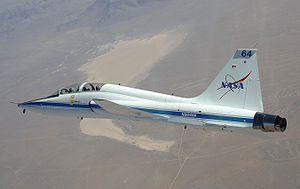 NASA Dryden's T-38 trainer aircraft in flight over Cuddeback Dry Lake in Southern California
NASA Dryden's T-38 trainer aircraft in flight over Cuddeback Dry Lake in Southern California
- United States Air Force has 459 T-38 trainers in service as of September 2008.[20])
- United States Navy has 10 aircraft in use as November 2008.[19]
- NASA (~32 aircraft)
Aircraft on display
- An AT-38B is on display at the Cold War Gallery of the National Museum of the United States Air Force. This aircraft was retired in 1991, came to the museum in 1999, and placed on display in 2004.[4]
One other aircraft is currently on display at the Kennedy Space Center visitor complex around 2010 at the front of orbiter Explorer, then was repositioned on the other side of the plaza fixed in an angled position behind the space mirror.
- The Evergreen Aviation & Space Museum in McMinnville, Oregon has T-38A 63-8224 painted in NASA colors suspended from the ceiling in their Air and Space Exhibit Hall.[21]
- The March Field Air Museum in Riverside California has T-38A 60-0593 on display in Thunderbirds markings.[22]
- The Plant 42 Heritage Airpark in Palmdale, California has T-38A 63-8182 on display.[23]
- The Pima Air and Space Museum in Tucson, AZ has T-38A, sn 61-0854, on display in the markings of the 49th Tactical Fighter Wing at Holloman AFB, NM, circa 1982.
- T-38A 60-0549 has been on display since 1993 at the Prairie Aviation Museum, in Bloomington, Illinois[24]
Specifications (T-38A)
Data from USAF factsheet[4]
General characteristics
- Crew: 2: student and instructor
- Length: 46 ft 4.5 in (14.14 m)
- Wingspan: 25 ft 3 in (7.7 m)
- Height: 12 ft 10.5 in (3.92 m)
- Wing area: 170 ft² (16 m²)
- Empty weight: 7,200 lb (3,270 kg)
- Loaded weight: 11,820 lb (5,360 kg)
- Max takeoff weight: 12,093 lb (5,485 kg)
- Powerplant: 2 × General Electric J85-5A (J85-5R after PMP modification) afterburning turbojets
- Dry thrust: 2,050 lb (9.1 kN) each
- Thrust with afterburner: 3,850 lbf (17.1 kN) each
Performance
- Maximum speed: Mach 1.3 (858 mph, 1,381 km/h)
- Range: 1,140 mi (1,835 km)
- Service ceiling: 50,000 ft (15,240 m)
- Rate of climb: 33,600 ft/min (170.7 m/s)
- Wing loading: 70 lb/ft² (340 kg/m²)
- Thrust/weight: 0.65
See also
- Related development
- Northrop F-5
- Northrop F-20 Tigershark
- T-X program
- Related lists
References
- Notes
- ^ Johnsen 2006, pp. 5–6.
- ^ Eden 2004, p. 344.
- ^ "Northrop marks 50th anniversary of T-38 Talon first flight." defencetalk.com, 14 April 2009. Retrieved: 21 August 2011.
- ^ a b c d e f g h "Northrop AT-38B Talon." USAF, 2 May 2008.
- ^ a b c d e "Aircraft - Make / Model Results: Northrop T-38." FAA Registry. Retrieved: 21 August 2011.
- ^ Creech, Gray. "T-38 Supersonic Trainer Jet Gets New Home." NASA. Retrieved: 21 August 2011.
- ^ "Crash Kills Astronaut." Richland, WA - Tri City Herald, 1 November 1964.
- ^ "Goose Hit Jet, Killing Astronaut." The Miami News, 17 November 1964.
- ^ "2 Astronauts Die In Plane Crash." The Tuscaloosa News, 28 February 1966.
- ^ "See - Bassett Backup Crew Gets Gemini." Daytona Beach, FL - Morning Journal newspaper, 1 March 1966.
- ^ "Williams Wanted To Be First On The Moon." St. Petersburg, FL -Evening Independent newspaper, 6 October 1967.
- ^ "Board Pinpoints Astronaut's Death." Sarasota, FL - Herald-Tribune newspaper, 7 June 1968.
- ^ "Two Civilian Test Pilots Die In Crash." Spartanburg, SC - Herald-Journal newspaper, 21 January 1972.
- ^ "Planes Grounded After Crashes," The New York Times, 2 May 2008, p. 14.
- ^ "T-38 crash claims life of Edwards' pilot." United States Air Force, 22 May 2009. Retrieved: 21 August 2011.
- ^ "USAF Braces For Fiscal Bombardment." Aviation Week & Space Technology, 20 September 2010.
- ^ "Modifications & Modernization T-38 Avionics Modernization Program." Turkish International Cooperation and Export Activities. Retrieved: 21 August 2011.
- ^ a b "World Military Aircraft Inventory". 2009 Aerospace Source Book, Aviation Week and Space Technology, 2009.
- ^ a b "Directory: World Air Forces." Flight International, 11–17 November 2008.
- ^ "The Air Force in Facts and Figures." Air Force Magazine, May 2009.
- ^ "Picture of the Northrop T-38A Talon aircraft." airliners.net. Retrieved: 11 August 2011.
- ^ "Picture of the Northrop T-38A Talon aircraft." airliners.net.Retrieved: 11 August 2011.
- ^ "Picture of the Northrop T-38A Talon aircraft." airliners.net.Retrieved: 11 August 2011.
- ^ "T-38." Prairie Aviation Museum. Retrieved: 21 August 2011.
- Bibliography
- Eden, Paul, ed. "Northrop F-5 family". Encyclopedia of Modern Military Aircraft. London: Amber Books, 2004. ISBN 1-9046-8784-9.
- Johnsen, Frederick A. Northrop F-5/F-20/T-38. North Branch, Minnesota: Specialty Press, 2006. ISBN 1-58007-094-9.
- Shaw, Robbie. F-5: Warplane for the World. St. Paul, Minnesota: Motorbooks International, 1990. ISBN 0-87938-487-5.
External links
- T-38 Talon USAF Fact Sheet
- T-38 Talon page on GlobalSecurity.org
- T-38 Talon page on SR-71.org
- NASA photo gallery
- "White Rocket," Air & Space Magazine, September 2005
Northrop aircraft Manufacturer
designations'Greek' series'N' seriesNote: Northrop company designations include a wide variety of technologies. Only aircraft, aero engines, and missiles are linked here.
N-1 · N-2 · N-3 · N-4 · N-5 · N-6 · N-7 · N-8 · N-9 · N-10 · N-12 · N-14 · N-15 · N-16 · N-18 · N-19 · N-20 · N-21 · N-23 · N-24 · N-25 · N-26 · N-29 · N-31 · N-32 · N-34 · N-35 · N-36 · N-37 · N-38 · N-39 · N-40 · N-41 · N-46 · N-47 · N-48 · N-49 · N-50 · N-51 · N-52 · N-54 · N-55 · N-59 · N-60 · N-63 · N-65 · N-67 · N-68 · N-69 · N-71 · N-72 · N-73 · N-74 · N-77 · N-81 · N-82 · N-94 · N-96 · N-102 · N-103 · N-105 · N-110 · N-111 · N-112 · N-117 · N-124 · N-132 · N-133 · N-134 · N-135 · N-138 · N-141 · N-144 · N-149 · N-150 · N-151 · N-155 · N-156 · N-205 · N-267 · N-285 · N-300'P' seriesP530 · P600 · P610
By role AttackBombersDronesFightersReconnaissanceTrainersT-38TransportsExperimentalNames Bantam · Black Bullet · Black Widow · Chukar · Nomad · Pioneer · Raider · Reporter · Scorpion · Snark · Talon · Tigershark
See also: TR-3USAAC/USAAF/USAF/Tri-service trainer aircraft Advanced Trainer Basic Combat Basic Trainer Primary Trainer (1924-1948) Trainer (1948-1990) "T-1", "T-2", "T-3" and "T-6" have also been assigned since 1962 in a separate sequence.Lists relating to aviation General Aircraft (manufacturers) · Aircraft engines (manufacturers) · Airlines (defunct) · Airports · Civil authorities · Museums · Registration prefixes · Rotorcraft (manufacturers) · TimelineMilitary Accidents/incidents Records Categories:- United States military trainer aircraft 1950–1959
- Northrop aircraft
- 1961 introductions
- Twinjets
Wikimedia Foundation. 2010.

